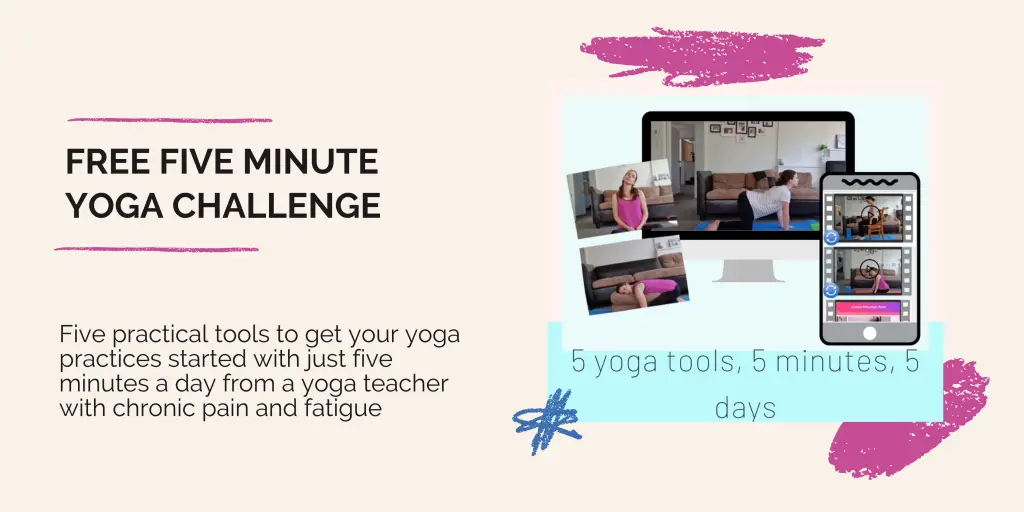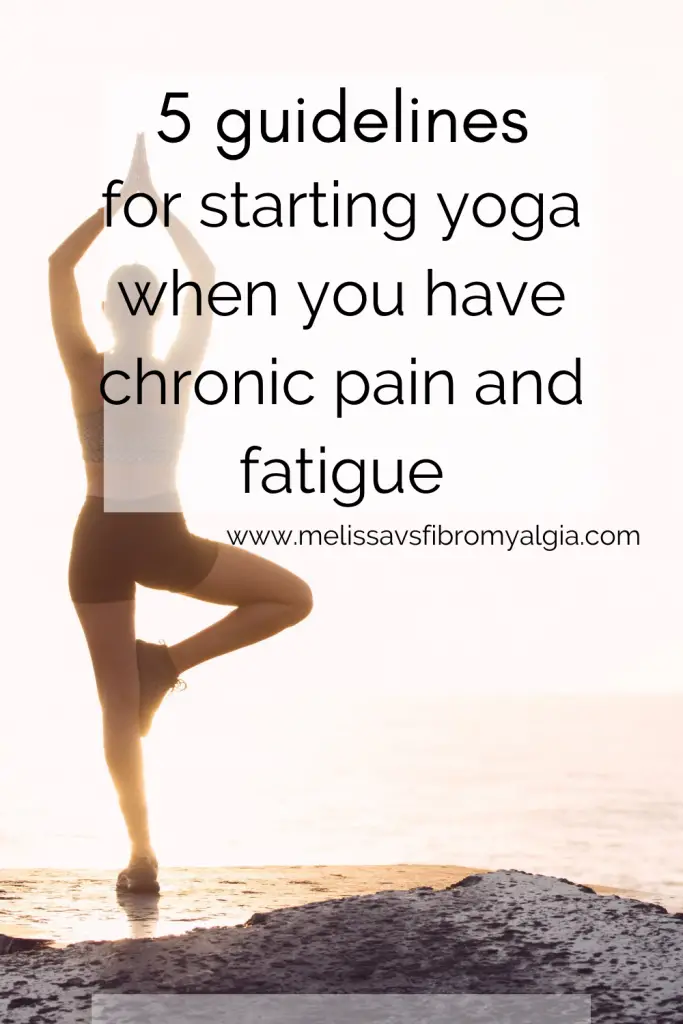Last Updated on March 24, 2024 by melissanreynolds
We are often told to start exercising when we have chronic pain and fatigue. But we aren’t really told how to do it safely and without increasing our symptoms.
It really does depend on what your goals are for your exercise.

I love yoga because it’s got some great side benefits. I am all about improving my quality of life. I would rather exercise for 10 good minutes and see symptom improvement, than the “recommended” amounts and see no improvement – or worse, an increase in symptoms.
So, in this video and post I am sharing my top five rules to start exercising with chronic pain and fatigue.
Start low and go slow
Take where you think you are able to start and reduce that by about 30%.
This means you can start at two minutes! I have heard of pain specialists who recommend 20 minutes every day, despite that figure being unattainable and downright painful.
Start with the least you think you can do without causing pain and fatigue flares. You can slowly increase the amount.
For example, if you start with walking for five minutes and that feels alright in your body during the session and afterwards. Then the next time you might try seven minutes. If that feels good, then you might try 10 minutes. Please note progress will not be linear. Some days we will feel better than others, and we can adjust for that. You may hit a ceiling at some point and stay there for some time. For me, for a long time, that was 20 minutes of walking. 20 minutes was comfortable, more caused more pain. As my condition overall improved (due to sleep, pacing, good rest etc.) then this moved to 30 minutes. Allow for your overall condition to guide you.
One way that helps us to start and continue moving slowly is to try some gentle yoga poses. Standalone stretches that can get you moving.
In my free five minutes a day for five days yoga pose challenge I share five standalone tools that can help you with a daily movement habit.

So, how do you know when to move up…
Listen to your body.
Does it feel good at the time?
How do you feel after your practice?
And how do you feel over the next couple of days?
Do what you will like and do
If we don’t like it, why would we prioritise it when we are tired and in pain (aka all the time)? Take some time to find what you like. And then commit to it for a time to make it a habit.
There are loads of options:
- Yoga
- Walking
- Tai Chi
- Strength training (weights)
- Recumbent bike (said to be good for joints)
- Cross trainer
- Seated bike (where you sit in a seat and use your legs to pedal)
- Pilates
- Swimming
- Water aerobics
and much more.
Quality not quantity
You are better off doing one great push-up than 10 poor-quality ones. The concept works with yoga, walking, and anything else. Do less with good form so you don’t add to your bodily stress and tension.
In terms of how often to do it, I’d start with a couple of times a week so that you can really assess how you feel between sessions. However, I have been doing every second day for my 5-10 minute strength-based/yoga sessions. And on the alternating day I will do a gentle walk.
You will know because one feature of fibromyalgia is post-exertion pain and a feature of ME/CFS is post-exertion malaise. If you’re tackled by one or both, then you’ve definitely overdone it. I get burning legs and fatigue if I do too much. So I’ve bought it right back to basics.
How to track it?
You can incorporate this into your regular tracking. I recommend symptom tracking, especially when you are trying new things.
I created The Movement Habit Tracker Sheets from my own tracking. I’ve had to restart my movement practice several times over the years. Including after a serious operation. Each time it was slow and methodical. And I share that with you. There’s two options of tracking sheets depending on how much detail you want to include (if you want to do some strength-based training or simply short exercises i.e.. 10 minute YouTube dance video or 15 minute walk).
It’s kind of my thing to systematize the difficult things we have to do. Moving is no different.

I hope this post has given you some helpful guidance to starting a movement practice with ME/CFS and fibromyalgia.
Read more
Ultimate Guide to Managing Fibromyalgia
Yoga for Chronic Pain and Fatigue

Yoga for Fibromyalgia Framework
My “framework” is: Breathe – Stretch – Rest. I believe in working with the central nervous system, not against it.
Also, I would argue the breathing and resting are more important than the stretching portion. But the beauty of this framework is that you can adapt it to your energy levels and needs on any given day.
5 minutes to breathe, 5 minutes to stretch, 10 minutes to rest.
2 minutes to breathe, 6 minutes to stretch, 2 minutes to rest.
